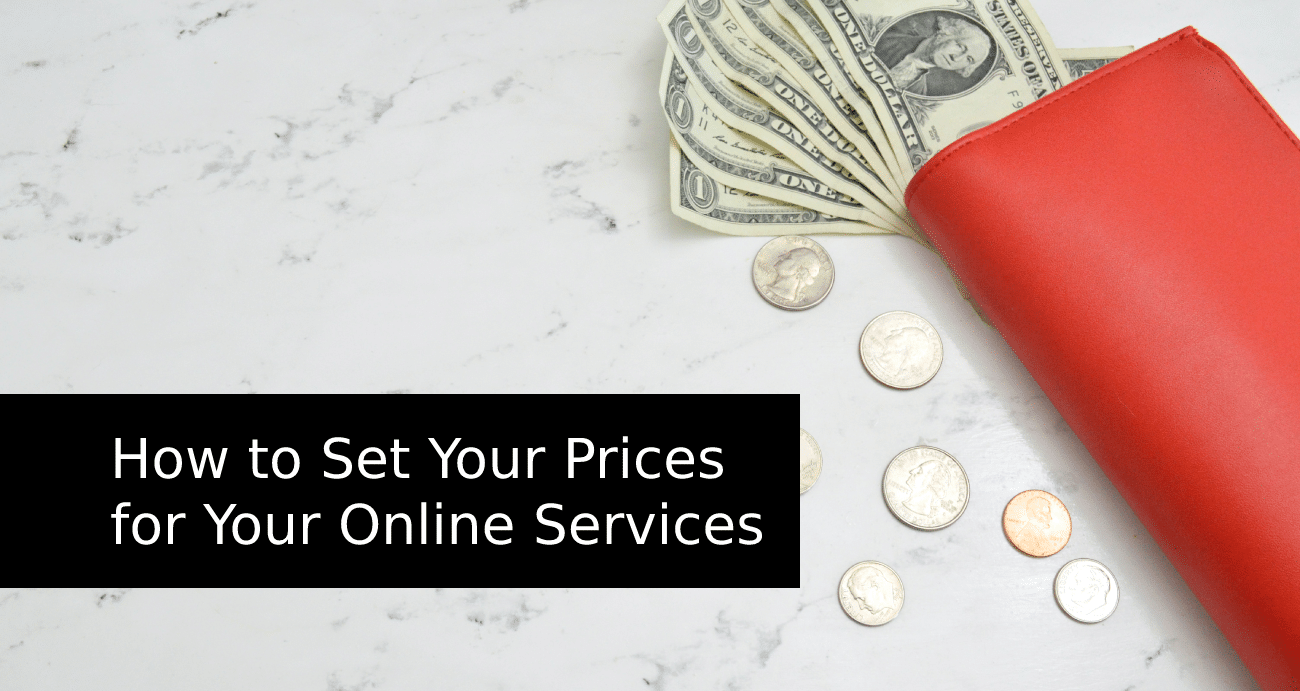Do you run an online business? Are you having a hard time determining the right price for your services? If yes, this easy pricing guide is for you.
Most service-based businesses find it hard to come up with fair yet profitable pricing strategies. Service pricing is far different from product pricing because you cannot exactly quantify all the costs going into rendering a service.
Don’t worry; you can make the process of setting online service pricing with this guide.
Your formula accounts for the intangible business operation aspects when pricing online services, including time and value. Take a look at the factors to consider in online service pricing to get a big picture:
1. Figure Out Business Costs
Determining how much it costs to provide online services can prevent shortchanging your business. To do so, you need to use cost-plus pricing. This standard pricing method seeks to determine the cost of providing a service initially. Then, you need to add the additional amount. You also need to identify the fixed costs, indirect costs, and direct costs to determine the cost.
-
- Fixed costs. You have to pay these expenses no matter what. They stay whether you provide five services or ten services a day.
-
- Indirect costs. You cannot pinpoint these expenses to a specific product. Plus, you need special attention to overhead expenses, including utilities, indirect labor, marketing, advertising, etc.
- Direct costs. These expenses go directly into providing online service. Manufacturing, direct labor, and direct materials are some of the examples of these expenses.
2. Compete on Competitor’s Prices
Part of setting your service pricing is determining what your competitor charge for similar services. If you’re a SaaS startup, a tech business, or any other related industry, you can easily find this information from your competitor’s site, published data, phone calls, and talking to people who have used their services.

Besides competing on services, features, and other factors, you also need to compete with a price to set you apart. If you want to win customers by competing on price, ensure that your customer is loyal even if your competitors offer services at a lower price.
Competing on price can be a little risky. That is why you have to convince your customers that you are providing them a tremendous service and quality value. Then, stay updated on what the competition charges.
Moreover, if you’re a freelancer and have been working remotely for a long time, you’ll have a general idea of the prices you have to demand. Joining freelance groups on social media can also help you a lot in determining your pricing strategy.
3. Identify the Value Proposition to the Customer
Regardless of how much you charge, you will not profit if your customers have no willingness to pay. So, ensure to understand how they perceive your service value and business. You can do that by knowing your customers.
You conduct a market study, where you can collect critical information about your customers. Determine how much your prospects and existing customers are willing to pay. Take a look at several factors like their pain points, needs, occupation, family status, income, etc.
You can also conduct focus groups or distribute surveys to know how much they are willing to pay for your online services.
4. Determine Your Profit Margin
Profit margin refers to how much a business brings in after subtracting the cost of goods sold. One of the best ways to achieve the desired profit is coming up with a fair margin. Profit margins often vary by industry. However, the 10% profit margin is generally average.
After determining your costs, your next big step is to markup your services. It requires a delicate balance. While you ensure that you will achieve the desired profit margin, you also need to ensure that your online service business will not gain a reputation of service overcharging.

You can search for resources within your industry, including annual statement studies on SMB financial benchmarks. You can use these resources to figure out whether the profit margin is on target.
Additionally, consider the time invested, your perceived value, the market, and your cost to get a fair profit margin.
Are you still not sure how to calculate profit margin? To ensure that your product’s selling price is attractive, reasonable, and profitable to your business, try to use an automatic online profit calculator.
Types of Pricing Strategies
You can use pricing strategies to price your online services. These methods cover different areas, such as margins, variable costs, market conditions, and customers’ willingness and ability to pay for your services.
Below are the common types of pricing strategies you can use for your online service business:
-
Penetration Pricing
This pricing strategy sets prices too low to gain market share. After that, it increases the rates over time once the customer base grows.
-
Economy Pricing
In this pricing strategy, you need to keep the costs to a minimum to provide the customers the best price. It sets low prices due to low overhead.
-
Price Skimming
This is where you need to set higher prices because you have a competitive advantage. It is effective, particularly if you have something special to offer to your customers. You can maximize the profits upfront while growing your business.
-
Psychological Pricing
This pricing strategy is designed to ensure that your customers will respond emotionally rather than rationally. For instance, customers find odd prices like $18.95 more attractive than round numbers like $19.
-
Product Line Pricing
If you choose this pricing strategy, you need to set progressively high prices for various online services.
-
Optional Product Pricing
In an optional product pricing strategy, getting your customers to spend more and upgrade on other services is involved. You can introduce it by offering it as an optional add-on.
Price Models
When setting up a price for your services, you also need to determine if you need to charge an hourly rate or flat rate or stick with the variable pricing. You can predetermine it based on the service pricing type dominating in your industry and by your industry as a whole.

For instance, lawyers charge their services based on hourly rates, though those rates vary. Most concrete construction companies charge a project fee. Then, they divide the payment: one third (paid upfront), another third (paid at the halfway point), and the remaining third (paid upon completion).
Take a look at the pricing models below to gain better insights.
-
Hourly Rate
An hourly rate ensures that you will get the rate on return on the labor and actual time invested in providing service to each customer. This pricing is generally used when pricing your own consulting services instead of services that use materials and labor from others.
The amount of seniority and expertise determines the rate. More senior consultants are often paid with higher hourly rates than junior or less experienced consultants.
-
Flat Rate
During tough economic times, most businesses prefer hiring their services only on a flat-fee or fixed-rate basis. Service business owners want hourly rates, but customers are more attracted to fixed rates.
If a project needs to be extended, you are at risk of losing money. If the customer asks for a flat rate, the best thing you can do is know whether the customer is willing to pay additional fees or put a cap on the number of hours if the project takes longer to complete than scheduled.
-
Variable Pricing
In determining a fair service price, you need to know whether you need to implement a fixed-price policy and then charge the same amount or institute variable pricing.
If you choose the variable pricing model, negotiating and bargaining will help you set a price for each customer. However, if you have a hard time charging different rates to different customers, this pricing model will not work for you. Plus, variable pricing may create ill will. For sure, you do not want to lose respect from customers and integrity.
What’s Next?
Your job does not stop after determining the price for your online services. You still need to perform the following to ensure that everything is on the right track.
-
Test Your Prices from Time to Time
Always test new combinations of premiums and benefits, offers, and prices to sell more services at a better price. The perfect time to do this is while quoting a price to new customers.
Then, you can raise the price while offering a new, unique special service or bonus to the customer.
-
Be Careful When Increasing Your Prices
Being wise about raising the prices is critical. While you need to raise your prices, ensure to monitor your price and costs regularly. That way, you can be competitive in the market while ensuring that you are making the money you deserve. Do not forget to find the perfect timing to raise your prices, particularly if your customers experience challenging financial issues.
-
Cross-Sell/Upsell
You also need to consider cross-selling or upselling. Cross-selling refers to the strategy where you will provide services related to the one that customers are already using. Upselling refers to the strategy where you need to deliver a superior, more expensive service version that customers are already using.
-
Integrate your Prices within your Proposals
If you’re sending out proposals, make sure your pricing is clear so as to avoid unnecessary confusion from potential clients. Also, adding your prices can help your clients know if they can really afford you or if they want any more negotiations. It’s also important to be specific where you’d allot their money if you’ll be managing a certain project. After all, transparency is essential in building a brand-customer relationship.
Create a detailed business proposal with ease using Prospero. It has a long list of proposal templates that are highly customizable based on your industry and preferences. Sign up with Prospero now!
Conclusion
Pricing services is often more challenging than pricing products. Plus, you need to determine which pricing strategy will work best for your service business. However, as long as you know where and how to start, you can determine the fair price for your services. Do not forget to know your customers so that you will have a better idea if they are willing to pay for a particular price you set.




